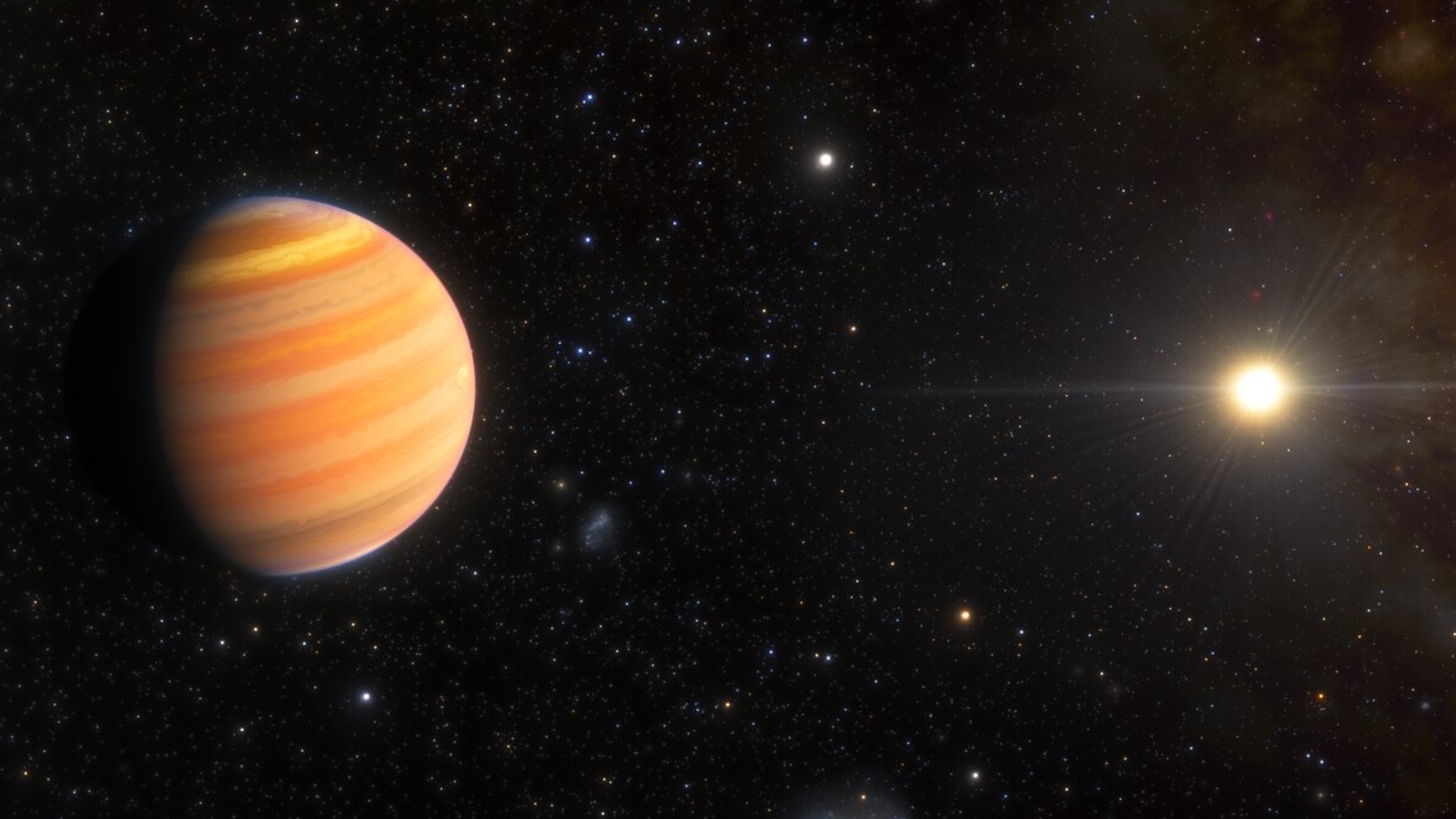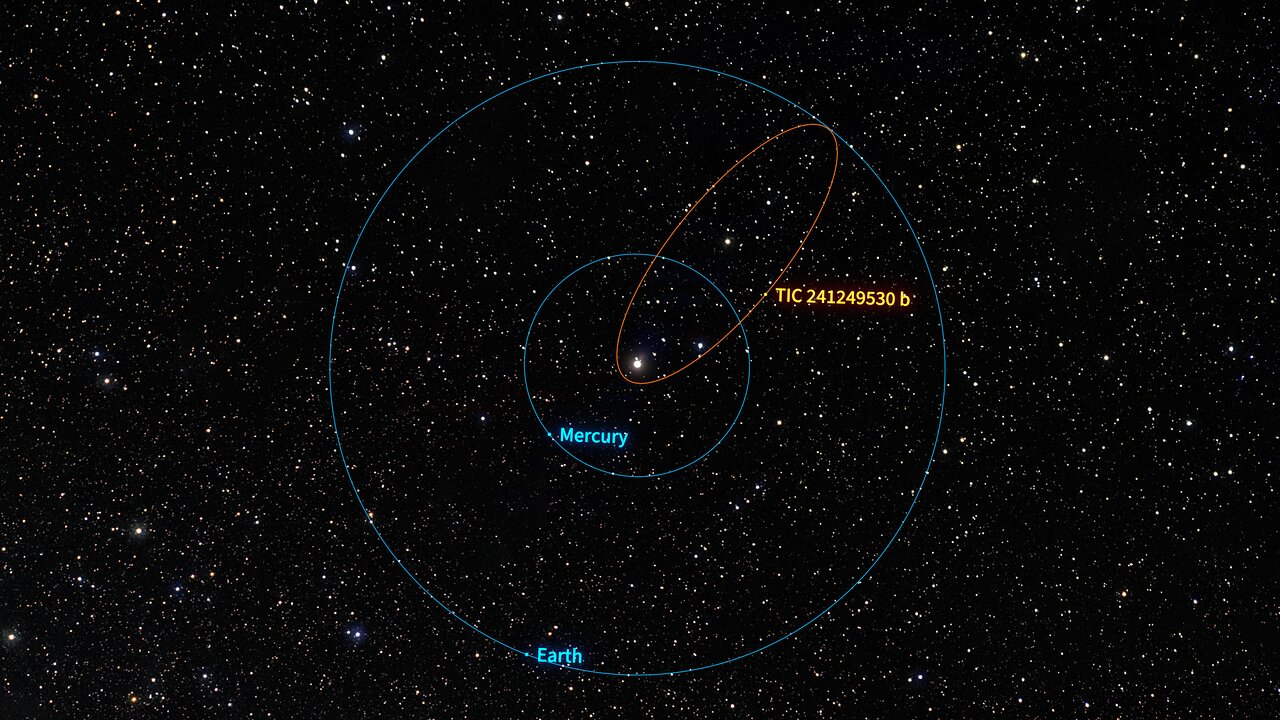Exoplanet with weird orbit is transforming into a hot Jupiter before our eyes
"Astronomers have been searching for exoplanets that are likely precursors to hot Jupiters for more than two decades, so I was very surprised — and excited — to find one."

There is more than meets the eye for a distant gas giant planet.
Astronomers have discovered that the extrasolar planet, or "exoplanet," not only has one of the weirdest orbits ever seen, but it is also transforming into a "hot Jupiter" world. Understanding this transformation could help scientists build a better picture of how the worlds in this curious class come about.
The exoplanet, designated TIC 241249530 b and located around 998 light-years from Earth, was first detected by NASA's Transiting Exoplanet Survey Satellite (TESS) in January 2020 when it crossed, or "transited," the face of its parent star.
The planet orbits its star, TIC 241249530, at a distance about 12% of the distance between between Earth and the sun. That proximity means that it completes an orbit in just 15.2 Earth days. But that isn't what is so extreme about this planet's orbit.
Related: Evidence of water found in atmosphere of mysterious 'metal god of war' exoplanet
Most planets don't have perfectly circular orbits. Rather, the bulk of planetary orbits are ellipticals with some degree of flattening, which astronomers call "eccentricity." TIC 241249530 b has one of the most stretched and flattened orbits astronomers have ever seen. Additionally, the Jupiter-size planet is orbiting its star "backward" in comparison to the star's rotation.
However, hot Jupiters are exoplanets that orbit their planets at distances that see them complete a year in just 10 Earth days or less. That means that TIC 241249530 b isn't a hot Jupiter — at least, not yet. Currently, it is something of a puzzle to astronomers just how hot Jupiters come so close to their parent stars, with scientists suggesting these planets form further away from their stars and then migrate inwards.
Get the Space.com Newsletter
Breaking space news, the latest updates on rocket launches, skywatching events and more!
Yet, the early stages of this migration process have remained frustratingly elusive, even after astronomers have observed and confirmed at least 5,600 exoplanets.
A team of astronomers used two instruments on the WIYN 3.5-meter Telescope at the Kitt Peak National Observatory (KPNO) to observe TIC 241249530 b and reveal it as an early-stage hot Jupiter.
"Astronomers have been searching for exoplanets that are likely precursors to hot Jupiters, or that are intermediate products of the migration process, for more than two decades, so I was very surprised — and excited — to find one," team leader Arvind Gupta, a NOIRLab postdoctoral researcher, said in a statement. "It's exactly what I was hoping to find."
A hot Jupiter in the making
The scientists first used the NN-EXPLORE Exoplanet and Stellar Speckle Imager (NESSI) to remove "twinkling" patterns caused by Earth's atmosphere, as well as reduce noise coming from other sources of light that could pollute the signal from the star TIC 241249530 as its planet transits its face.
Next, they measured the velocity of the exoplanet around the star using the NEID spectrograph to determine the star's shift in light.
"NESSI gave us a sharper view of the star than would have been possible otherwise, and NEID precisely measured the star's spectrum to detect shifts in response to the orbiting exoplanet," Gupta said.
The team's analysis of this spectrum confirmed that TIC 241249530 b has a mass approximately five times that of Jupiter. The investigation also revealed the planet's extremely eccentric orbit. The eccentricity of a planet's orbit is measured on a scale from 0 to 1, with 0 being a perfectly circlular orbit and 1 being highly elliptical.
Dwarf planet Pluto's highly elliptical orbit around the sun has an eccentricity of 0.25, for context, while the Earth's near perfectly circular orbit has an eccentricity of 0.02. The orbit of TIC 241249530 b has an eccentricity of 0.94, which is more eccentric than the orbit of any other exoplanet ever found via the transit method of exoplanet detection.
There is notably another planet with a more flattened orbit, HD 20782 b, a gas giant located 1117 light-years away. Its orbit has an eccentricity of 0.956, but this world wasn't discovered using the transit method.

If TIC 241249530 b were placed in the solar system, its orbit would bring it 10 times closer to the sun than Mercury (which is about 3 million miles, or 4.8 million kilometers) and then right out to Earth's maximum distance from the sun (about 95 million miles, or 153 million kilometers). This would cause temperature variations on TIC 241249530 b to swing from those of a nice summer day on Earth to hot enough to melt lead.
The movement of TIC 241249530 b around its star had another unusual feature, too. The planet orbits its star in the opposite direction to the star's rotation, something called "retrograde motion." This is something rarely seen in exoplanets.
Both of these aspects of TIC 241249530 b's orbit tipped the team off to its impending transformation to a hot Jupiter. The team thinks that, as this highly eccentric orbit brings the planet close to its star, the orbit will begin to fill out like the 2D shadow of an inflating beach ball. This is expected to happen because tidal forces generated by the star's gravity draw orbital energy away from the exoplanet.
As the planet's orbit "circularizes," it will also shrink, drawing TIC 241249530 b closer to its star and giving it a year that lasts under 10 Earth days, signaling that transformation to a hot Jupiter is complete.
TIC 241249530 b is just the second exoplanet discovered that appears to be in the hot Jupiter pre-migration phase. Both TIC 241249530 b and the prior example of such a hot Jupiter precursor seem to support the transformation of higher-mass gas giants to hot Jupiters via their migration from highly eccentric orbits to tighter and more circular orbits.
"While we can't exactly press rewind and watch the process of planetary migration in real-time, this exoplanet serves as a sort of snapshot of the migration process," Gupta concluded. "Planets like this are incredibly rare and hard to find, and we hope it can help us unravel the hot Jupiter formation story."
The team's research was published on July 17 in the journal Nature.
Editor's note: This article was corrected to clarify that the orbits of all the solar system planets are prograde; Venus and Uranus display retrograde rotation, not retrograde motion.
Join our Space Forums to keep talking space on the latest missions, night sky and more! And if you have a news tip, correction or comment, let us know at: community@space.com.

Robert Lea is a science journalist in the U.K. whose articles have been published in Physics World, New Scientist, Astronomy Magazine, All About Space, Newsweek and ZME Science. He also writes about science communication for Elsevier and the European Journal of Physics. Rob holds a bachelor of science degree in physics and astronomy from the U.K.’s Open University. Follow him on Twitter @sciencef1rst.









